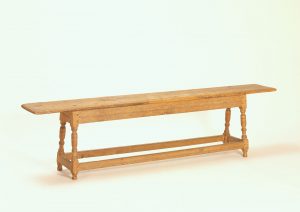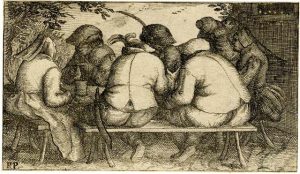Seating and Social Hierarchy: Winterthur’s 17th Century Form
Forms as seating furniture have a long history from Medieval Europe to the early modern age in America. During this period, seating furniture was reflective of a highly organized social hierarchy in communal dining situations. Forms were low ranking seats that were utilitarian and heavily used, so few survived to today. An American-made form in the Winterthur Collection is the sole known American joined form from the 17th century to have survived and is attributed to the Scituate or Marshfield shops in Massachusetts. [1]
According to the Oxford English Dictionary the term “form” as a piece of furniture is applied to “a long seat without a back, a bench.” [2] Though bench and form could be used interchangeably, bench more typically referred to a seat built into the walls while freestanding benches were called forms.[3] Randle Holme, in his 1688 publication The Academy of Armory described this object type:
These are termed Joynt forms, because wholy and workmanlike made, by Artist of the Joyners craft. Some are made with turned feete, 4 or 6, according to its length, having railes or Barres both above, for the seate to be fixed upon, and below, to hole the feete firme and stiddy. If the covers be broad then they are blazoned, Tables. [4]
Not only does this description indicate the common features of a joined form, all of which are present in Winterthur’s form, but it also explains how the form could be a multipurpose object that was used as both a seat and a table.

Form (Joined Form), Scituate or Marshfield, Plymouth, Massachusetts, New England, United States, North America, 1650-1700, Soft maple, Black ash, White pine. Museum purchase, Winterthur Museum, 1956.0094.006.
During the medieval period of the form’s use as a seating object, dining was a communal, public activity that took place in the great hall. Several different types of seating furniture were used, and the type of seat one used was determined by rank. Great chairs were reserved for the patriarchal figure or those with high social rank. Lower ranking diners used joint stools or extended joint stools (forms). This ranking in seating is evident in the etymology of the term form, which originated in the old French phrase s’esseoir en forme, or to sit in a row with a fixed order. [5]
In medieval dining, dishes, utensils, and drinks were shared between several people who also shared the same seating furniture. [6] This open sharing indicates a different conceptualization of the individual and personal space than exists today. As time went on, dining practices began to change, and it became a more private activity. Nevertheless, during the 16th and 17th century joint stools and forms or benches remained common. [7]
Joint stools and forms were used in many places outside of the great hall. The ubiquity of their use is evident in period arts and prints. “The Winchester Wedding” print (ca. 1682-3) depicts a rustic wedding scene with a man in the foreground sitting on a form with a drinking goblet and a pitcher. This image shows that forms would have been used in taverns and other similar establishments as well as within the household. Another print created sometime from 1660 to 1680 further exemplifies the low status of forms since peasants are seated communally on this object type.

Robert Robinson, “The Winchester Wedding,” Mezzotint, 1682/3, The British Museum, London, British Printed Images to 1700.

Robert Pricke, “Group of Dutch peasant on benches around table engaged in animated discussion,” Etching, 1660-80, The British Museum, London, British Printed Images to 1700.
Long forms in America are not as common as they were in England. [7] Instead, joint stools were more common. Nevertheless, forms were owned and used in New England households. According to an examination of various probate inventories from Hampshire County in Massachusetts from 1665-1680, 12.8% of the inventories listed forms while 21.3% and 38.3% listed joint stools and chairs, respectively. [8]
Furthermore, these probates record domestic use, and forms were also used communally outside of the home. Like in Europe and England, forms would have been used in taverns and other public spaces. Forms and benches, as communal seating objects would have been suited for use in churches and meeting houses. The Quakers Meeting print from the 1680s displays the use of forms as communal seating objects during a religious meeting. Forms were common utilitarian object within early colonial homes and public venues that would have received hard use. In that respect, the survival of this object as the only known example of a 17th century American form is remarkable.

Isaac Beckett, “The Quakers Meeting,” Mezzotint, 1683/8, The British Museum, London, British Printed Images to 1700.
By Sara McNamara, WPAMC Class of 2018
Endnotes:
[1] The Scituate and Marshfield shops are closely linked through geography, as they are both towns along the southern shore of Massachusetts Bay that attracted artisans from Plymouth. The shops in those areas shared kinship ties as it was common for intermarriage of families in similar professions in Puritan society as a way to consolidate power, and this practice led to the formation of craft dynasties For more information on the joiners of New England in the 17th century see Robert F. Trent, “New England Joinery and Turning before 1700” in the 3rd volume of New England Begins; Robert F. Trent, The Joiners and Joinery of Middlesex County, Massachusetts, 1630-1730 (Master’s thesis ,University of Delaware, 1975) 2; and Jonathan L. Fairbanks and Robert F. Trent, New England Begins: The Seventeenth Century Volume 2 Mentality and Environment (Boston: Museum of Fine Arts, 1982) 218.
[2] Oxford English Dictionary, Volume IV, (Oxford: Clarendon Press, 1933) 461.
[3] Randle Holme explains the interchangeable terms for this object type stating, “a countrey stoole, or a planke, or Block stoole, being onely a thick peece of wood, with either 3 or 4 peece of wood fastned on it for feet. Note that if these be made long, then they are termed, either a Bench, a Forme, or a Tressell; of some a long seate.” Randle Holme. The academy of armory: or, A storehouse of armory and blazon. Containing the several variety of created beings, and how born in coats of arms, both foreign and domestick. With the instruments used in all trades and sciences, together with their terms of art. Also the etymologies, definitions, and historical observations on the same, explicated and explained according to our modern language … Second volume, (London: Printed for the Roxburghe club, 1905) 15. Wintherthur Museum Library, The Collection of Printed Books and Periodicals.
[4] Randle Holme. The academy of armory, 15.
[5] The etymology of this definition is attributed to Old French and the earliest recorded usage of the word in this way was traced to the 14th century. Oxford English Dictionary, 461.
[6] Peter Brears, Cooking and Dining in Tudor and Early Stuart England (London: Prospect Books, 2015) 475, 483.
[7] Wallace Nutting, Furniture of the Pilgrim Century (of American Origin) 1620-1720, with Maple and Pine to 1800, Including Colonial Utensils and Wrought-Iron House Hardware into the 19th Century. (Framingham, MA: Old America Company Publishers, 1924) 388.
[8] The 47 inventories from 1665-1680 that I examined were selected based on their legibility, as the goal was a basic statistical analysis. The inventories indicated a farming community as land and animals were often listed, but furniture was not always itemized. Thus, the probates do tell us that forms were present, but we cannot be sure if they were more common than these documents suggest. Probate Records, Hampshire County, Massachusetts, 1660-1820, (Northhampton, MA: Registry of Probate Records) microform Winterthur Museum Joseph Downs Collection of Manuscripts and Printed Ephemera.


Leave a Reply